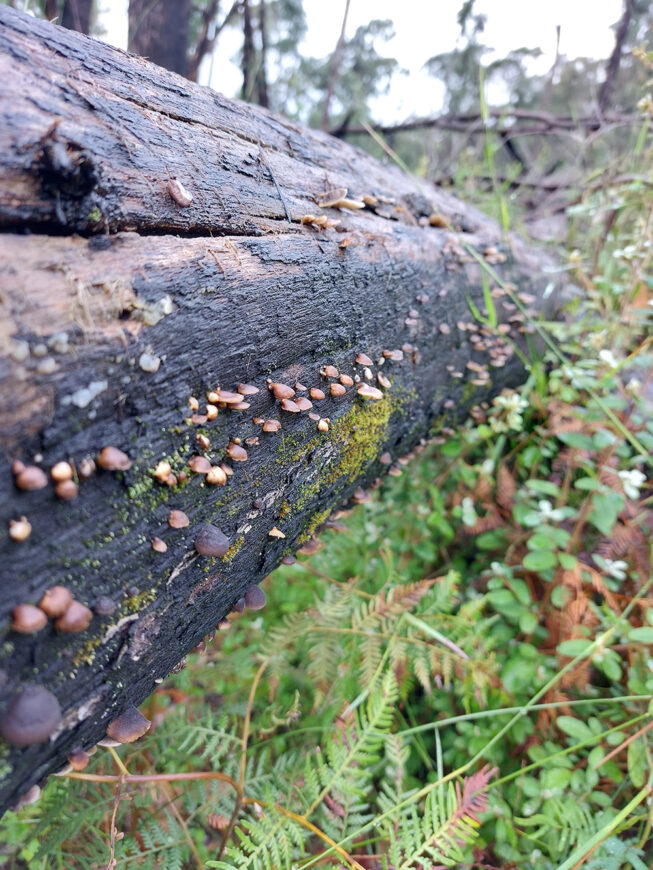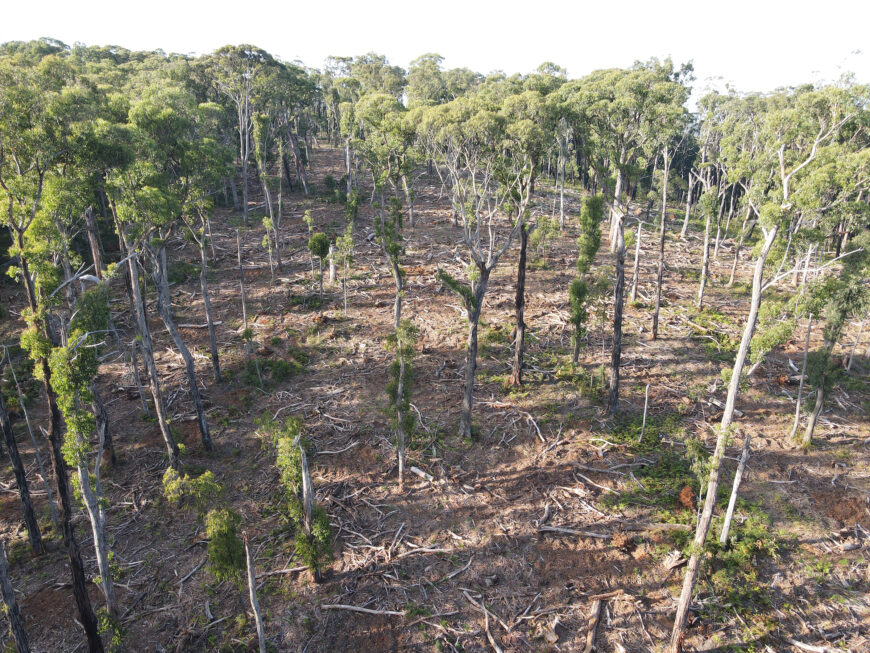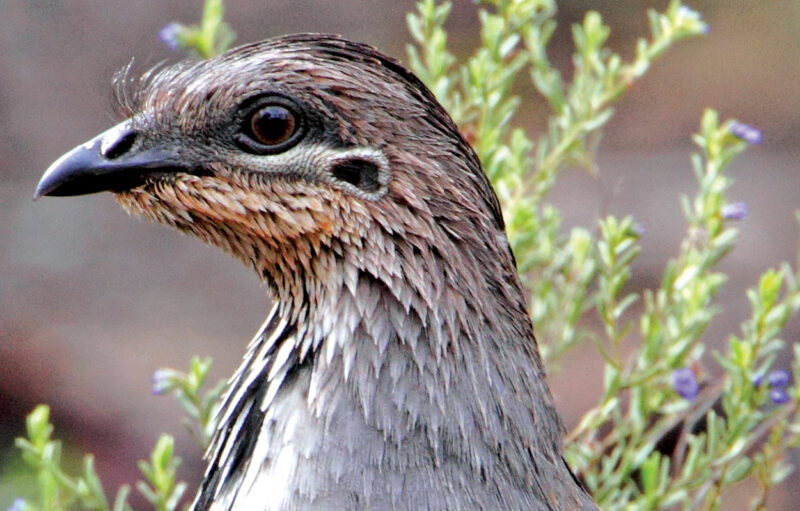PARK WATCH Article June 2023 |
Nature Conservation Campaigner Blake Nisbet on the fight against rogue logging in Dandenong Ranges National Park and Silvan Reservoir
Immense local pushback has thwarted another proposal to ‘salvage log’ the beloved Dandenong Ranges National Park. But it is unclear how long the pro-nature community can keep the logging machinery at bay.

Scope of work revealed
The scale of proposed logging continues to evolve. Forest Fire Management Victoria (FFMV) initially scheduled broadacre salvage logging but has scaled back their plan to roadside ‘edge treatment’, removing windthrown trees within one tree length of the roads. One proposal involves clearing a 60 metre wide firebreak within the national park (in addition to other completed firebreak operations).
VNPA started on-ground habitat surveys at one of the sites, documenting over 50 hollow-bearing trees in the area earmarked for logging. These trees survived the devastating 2021 storm event and serve an important role as habitat for hollow-dependent native wildlife. This includes endangered Greater Gliders and Gang-Gang Cockatoos, who both rely on these trees for denning and nesting.
We are incredibly concerned that these hollow-bearing trees may be removed if salvage logging commences. These trees are often identified as hazardous to machinery workers and removed for occupational health and safety reasons. FFMV say they’ll be doing on-site assessments to locate feeding and nesting trees, but we are yet to see any survey results from the department.
We hold deep concerns about the potential impacts of fallen tree removal and the destruction of understorey habitat on the Tooarrana (Broad-toothed Rat), an endangered rodent that needs understorey vegetation and fallen logs to nest under. Many of the fallen trees targeted for removal are absorbing lots of water, creating a wet and cool microclimate that supports an array of fungi and moss. If respected and left as habitat, these water-soaked trunks and branches would serve as a natural fire retardant.
A concerned member of the public shared recent drone imagery with VNPA that shows intensive ‘salvage logging’ in the Silvan Reservoir catchment, directly adjacent the national park. VicForests was contracted by Melbourne Water to undertake the operations with the justification of reducing the hazardous fuel load in post-storm areas.
What happens after rogue logging?
In the aftermath of rogue logging the understorey vegetation is decimated. Formally sheltered topsoil is exposed to sunlight, reducing soil moisture levels that would naturally help decrease bushfire intensity.
After larger trunks are taken and sold as firewood, sawlogs and pulp, the finer fuels remain on site. These comprise mostly of small branches, sticks and leaves, often referred to in the industry as ‘logging slash’. Melbourne Water plans to burn the ‘slash’, further drying out the soil and threatening any surviving hollow-bearing trees. A burn like this will remove fine fuels temporarily but ultimately regenerate as a dense forest understorey of high fire risk in 5–10 years.
Faulty self-assessment
Melbourne Water assessed themselves to see if their operations are likely to affect federally listed threatened plants and animals, and make sure they meet the obligations of the Environment Protection and Biodiversity Conservation Act 1999. This publicly-released assessment concluded that it was unlikely their logging operations would significantly impact any nationally endangered species, dusting off any legal responsibility.
Using the Greater Glider and Tooarrana (Broad-toothed Rat) as examples, the assessment states that their pre-logging populations were largely unknown, as both animals are ‘rarely observed or surveyed’.

It is worth noting here that the Silvan Reservoir is a closed catchment and not accessible to citizen scientists or the public. The assessment did not involve targeted fauna surveys which occurred for these endangered animals before they started logging. This highlights a significant issue with our federal environmental department, who chose to abdicate responsibility and leave state agencies to self-assess.
The self-assessment report states that VicForests voluntarily applies the rules that govern logging, the Code of Practice for Timber Production, throughout these salvage logging operations, despite no legal obligation or oversight in them doing so. This would require the application of a provision known as ‘the precautionary principle’, which VicForests has been found to breach time and time again by the Supreme Court, including for Greater Gliders in forests across Victoria. The Supreme Court found that to satisfy the precautionary principle in relation to Greater Gliders, comprehensive surveys are required prior to logging. None were undertaken in the Silvan Reservoir catchment.
Our work protecting the Dandenong Ranges National Park from rogue salvage logging continues, and the aftermath of the Silvan Reservoir operations serves as a clear reminder as to why it is so important that we succeed in keeping this incredible web of life safe.
FFMV announces raft of changes
Just as Park Watch was going to print, we caught wind of changes to FFMV’s plans for the national park.
Storm debris removal will be reduced to 40 metres off tracks at the two sites (a total of 50 hectares), compared to the original plan for broadacre works with areas cleared for log landings.
Debris clearing will be limited in sensitive areas or where the storm impact has been minor to targeted roadside verges.
Preparatory road works to commence in late May, and operations to start shortly after when weather is suitable (targeting some areas prior to winter and returning in summer to finish it off).
The Arthur Rylah Institute for Environmental Research are studying this as part of a long-term research project. Data was collected on recovery of forest prior to operations commencing. They will monitor the recovery after further disturbance events of debris removal, and after planned burning.
FFMV has also committed to:
- Retain refuges in the under- and midstorey for connectivity.
- Protect canopy trees.
- Exclude Riparian areas and areas around water bodies from logging.
- Protect all hollow bearing, den, sap feed trees and tree ferns, and create exclusion zones around nesting trees during breeding season.
- No machinery disturbance in areas of dense, swampy vegetation in gullies and other damp areas where threatened and protected species have been recorded.
- The identification, marking and protection of nest and roost sites.
While these are steps in the right direction, when comparing the Department’s maps we’re still seeing planned operations in areas that didn’t experience storm impact.
FFMV acknowledge that the works will only partially reduce the intensity of future bushfires. VNPA’s work is far from done but with community pressure and continued field work,we can hold these agencies to account and gain even greater oversight and protection of the national park.
Donate to help stop rogue logging
- Read the latest full edition of Park Watch magazine
- Subscribe to keep up-to-date about this and other nature issues in Victoria
- Become a member to receive Park Watch magazine in print
